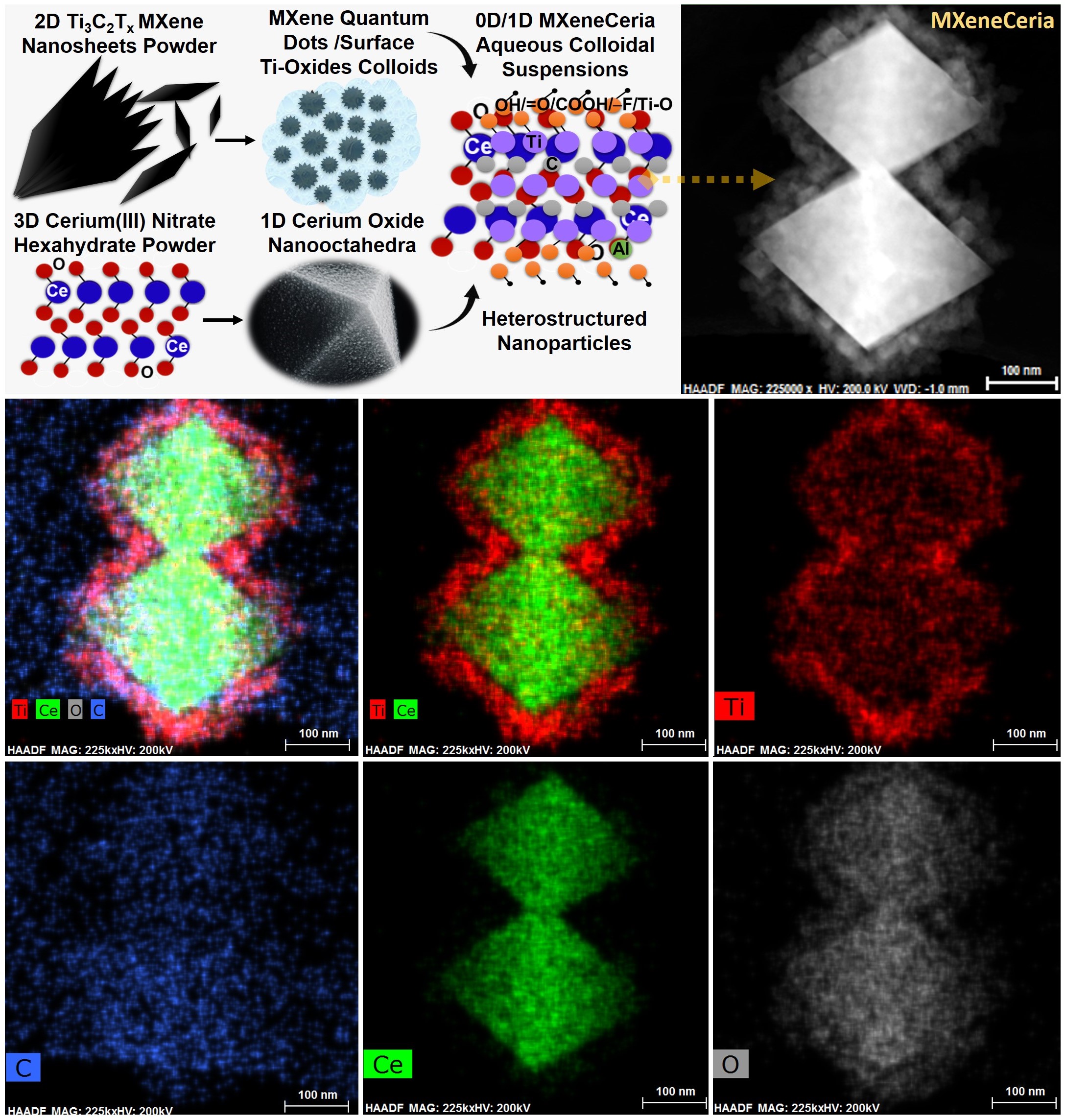Synthesis and Characterization of Novel MXeneCeria Heterostructure by Integration of Ti3C2Tx Quantum Dots into Fluorescent Nano-octahedral CeO2
DOI:
https://doi.org/10.13052/ijts2246-8765.2024.044Keywords:
Ti3C2Tx-CeO2, stable nanocolloids, autofluorescent, surface titanium oxides, 0D/1D biomaterialAbstract
Herein, we report the synthesis of a new stable zero/one-dimensional composite heterostructure “MXeneCeria” by integrating titanium carbide MXene (Ti3C2Tx) nanosheets-derived quantum dots with nano-octahedral particles of ceria (CeO2). This unique assimilation resulted in the formation of an auto-fluorescent aqueous colloidal material, which is detectable in fluorescent colors across various wavelengths, ranging from blue to green and red. The unique physicochemical properties of MXeneCeria make it a very promising nanocomposite and it may open a gateway to its potential applications in the biomedical field including tracking, immunoengineering, cell therapy, and targeted drug delivery.
Downloads
References
Dobrovolskaia, Marina A., and Scott E. McNeil. “Immunological Properties of Engineered Nanomaterials.” Nature Nanotechnology 2, no. 8 (2007): 469–78. https://doi.org/10.1038/nnano.2007.223.
Zheng, Yuanyuan, Xiangqian Hong, Jiantao Wang, Longbao Feng, Taojian Fan, Rui Guo, and Han Zhang. “2D Nanomaterials for Tissue Engineering and Regenerative Nanomedicines: Recent Advances and Future Challenges.” Advanced Healthcare Materials 10, no. 7 (2021): 2001743. https://doi.org/10.1002/adhm.202001743.
Chuang, Skylar T., Brandon Conklin, Joshua B. Stein, George Pan, and Ki-Bum Lee. “Nanotechnology-enabled immunoengineering approaches to advance therapeutic applications.” Nano Convergence 9, no. 1 (2022): 19. https://doi.org/10.1186/s40580-022-00310-0.
Sang, Wei, Zhan Zhang, Yunlu Dai, and Xiaoyuan Chen. “Recent advances in nanomaterial-based synergistic combination cancer immunotherapy.” Chemical Society Reviews 48, no. 14 (2019): 3771–3810. https://doi.org/10.1039/C8CS00896E.
Soleymaniha, Mohammadreza, Mohammad-Ali Shahbazi, Ali Reza Rafieerad, Aziz Maleki, and Ahmad Amiri. “Promoting role of MXene nanosheets in biomedical sciences: therapeutic and biosensing innovations.” Advanced healthcare materials 8, no. 1 (2019): 1801137. https://doi.org/10.1002/adhm.201801137.
Rafieerad, Alireza, Weiang Yan, Ahmad Amiri, and Sanjiv Dhingra. “Bioactive and trackable MXene quantum dots for subcellular nanomedicine applications.” Materials & Design 196 (2020): 109091. https://doi.org/10.1016/j.matdes.2020.109091.
Unal, Mehmet Altay, Fatma Bayrakdar, Laura Fusco, Omur Besbinar, Christopher E. Shuck, Süleyman Yalcin, Mine Turktas Erken et al. “2D MXenes with antiviral and immunomodulatory properties: A pilot study against SARS-CoV-2.” Nano Today 38 (2021): 101136. https://doi.org/10.1016/j.nantod.2021.101136.
Rafieerad, Alireza, Weiang Yan, Keshav Narayan Alagarsamy, Abhay Srivastava, Niketa Sareen, Rakesh C. Arora, and Sanjiv Dhingra. “Fabrication of smart tantalum carbide MXene quantum dots with intrinsic immunomodulatory properties for treatment of allograft vasculopathy.” Advanced Functional Materials 31, no. 46 (2021): 2106786. https://doi.org/10.1002/adfm.202106786.
Arora, Sumit, Jyutika M. Rajwade, and Kishore M. Paknikar. “Nanotoxicology and in vitro studies: the need of the hour.” Toxicology and applied pharmacology 258, no. 2 (2012): 151–165. https://doi.org/10.1016/j.taap.2011.11.010.
Ernst, Lena M., and Victor Puntes. “How Does Immunomodulatory Nanoceria Work? ROS and Immunometabolism.” Frontiers in immunology 13 (2022): 750175. https://doi.org/10.3389/fimmu.2022.750175.



